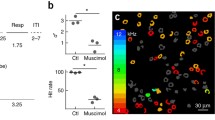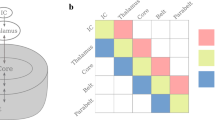Abstract.
A model of the CA3 region of the hippocampus was used to simulate the P50 auditory-evoked potential response to repeated stimuli in order to study the neuronal circuits involved in a sensory-processing deficit associated with schizophrenia. Normal subjects have a reduced P50 auditory-evoked potential amplitude in response to the second of two paired auditory click stimuli spaced 0.5 s apart. However, schizophrenic patients do not gate or reduce their response to the second click. They have equal auditory-evoked response amplitudes to both clicks. When schizophrenic patients were medicated with traditional neuroleptics, the evoked potential amplitude to both clicks increased, but gating of the second response was not restored or improved. Animal studies suggest a role for septohippocampal cholinergic activity in sensory gating. We used a computational model of this system in order to study the relative contributions of local processing and afferent activity in sensory gating. We first compared the effect of information representation as average firing rate to information representation as cell assemblies in order to evaluate the best method to represent the response of hippocampal neurons to the auditory click. We then studied the effects of nicotinic cholinergic input on the response of the network and the effect of GABAB receptor activation on the ability of the local network to suppress the test response. The results of our model showed that nicotinic cholinergic input from the septum to the hippocampus can control the flow of sensory information from the cortex into the hippocampus. In addition, postsynaptic GABAB receptor activation was not sufficient to suppress the test response when the interstimulus interval was 500 ms. However, presynaptic GABAB receptor activity may be responsible for the suppression of the test response at this interstimulus interval.
Similar content being viewed by others
Author information
Authors and Affiliations
Additional information
Received: 3 December 2001 / Accepted: 23 October 2002 / Published online: 28 February 2003
Correspondence to: K. A. Moxon (e-mail: karen.moxon@drexel.edu, Tel.:+1-215-8951959, Fax: +1-215-8954983)
Supported by USPHS, MH01245, MH58414, MH-50787, MH-01121, and research grants from the Department of Veterans Affairs and the National Alliance for Research on Schizophrenia and Depression.
Rights and permissions
About this article
Cite this article
Moxon, K., Gerhardt, G., Gulinello, M. et al. Inhibitory control of sensory gating in a computer model of the CA3 region of the hippocampus. Biol. Cybern. 88, 247–264 (2003). https://doi.org/10.1007/s00422-002-0373-7
Issue Date:
DOI: https://doi.org/10.1007/s00422-002-0373-7




